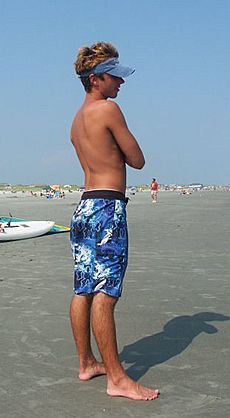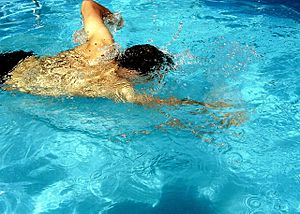Human swimming facts for kids
Swimming is when you move your body through water using your arms and legs. Usually, you don't need special gear. People swim for exercise, fun, or as a sport in competitions.
You use your arms and legs to swim. There are different ways to swim, called 'strokes.' Some popular ones are the breaststroke, front crawl, butterfly, and backstroke. The front crawl is often the fastest. Many people like the breaststroke because it feels relaxing.
Swimming can be a competitive sport. Many schools use swimming for physical training. Some swimming is just for fun, like doing backflips underwater.
You can swim in the sea, swimming pools, rivers, and lakes.
Swimming has been around for a very long time. Humans learned to swim by watching sea creatures. Over time, people became very good and fast swimmers.
Swimming uses almost all your muscles at once. It's also easy on your joints because you're floating in water.
Competitive swimming became popular in the 1800s. The main goal in competitive swimming is to always improve your own times or to beat other swimmers in a race. Before a big competition, swimmers often reduce their training to be at their best. They might also shave off body hair to feel faster in the water.
Contents
Swimming Styles
There are several main styles, or strokes, in swimming:
- Front crawl: This is the fastest and most efficient way to swim. It's also called freestyle because swimmers use it in freestyle races.
- Backstroke: This is the only stroke where you swim on your back, looking up at the sky. It uses a similar leg kick to the front crawl.
- Breaststroke: This is one of the easiest and most relaxing strokes for beginners. However, competitive swimmers find it hard to swim fast because it uses a lot of energy.
- Butterfly: This stroke is powerful and fast. It needs good technique and uses a special 'dolphin kick.' It's often considered the hardest stroke to learn.
Swimming Lessons
Even very young children can learn to be safe in water. Today, infant swimming lessons are often suggested to help prevent drowning accidents.
In some countries like Sweden, Denmark, Norway, Estonia, and Finland, schools teach children how to swim. By the fifth grade (or fourth grade in Estonia), children are expected to swim 200 metres (660 ft) (about two football fields), including at least 50 metres (160 ft) on their back. This is after they've practiced falling into deep water and getting their head wet. Even though most Swedish kids know how to swim, drowning is still a common cause of death for children there.
In the Netherlands and Belgium, the government helps schools offer swimming lessons. This is a long tradition in these countries. In France, swimming is a required part of primary school. Children usually spend one school term each year learning to swim.
Many local swimming pools offer lessons. These can be run by the city or by private companies. Many schools also include swimming lessons in their physical education classes. They might use the school's own pool or a nearby public pool.
In the UK, there's a program for children who can't swim by age 11. They get special daily lessons. If they haven't met the national standard of swimming 25 meters by the time they leave primary school, they get a short lesson every day for two weeks during term time.
In Canada and Mexico, there have been calls to add swimming to public school lessons.
In the United States, the Infant Swimming Resource (ISR) program teaches babies how to handle water emergencies. They learn how to hold their breath, roll onto their back, and float until help arrives.
Swimwear and Gear
Swimsuits

Regular clothes are usually not good for swimming and can even be unsafe. Most people today wear swimsuits when they go swimming.
Men's swimsuits often look like shorts or briefs. Casual men's swimsuits, like boardshorts, are usually not tight. But competitive swimwear for men, like jammers, are very tight. Most boys and men swim with their upper body uncovered, unless it's against local rules or they want sun protection.
Modern women's swimsuits are usually tight. (See bikini). Women's swimwear can also cover the middle part of the body. Women's swimwear often follows fashion trends.
Competitive swimwear is designed to help swimmers go faster and more smoothly through the water. It's usually tight and lightweight. There are many types for both boys and girls. It's used in sports like water polo, swim racing, and diving.
Wetsuits help keep you warm and make you float better. They are great for swimming in cold water for a long time. Wetsuits work by trapping a thin layer of water next to your skin, which then warms up from your body heat. They help prevent you from getting too cold, which is called hypothermia.
Accessories
- Ear plugs stop water from getting into your ears.
- Noseclips can stop water from getting in your nose. These are mostly used for synchronized swimming or just for fun. Competitive swimmers usually don't use them.
- Goggles protect your eyes from chlorine in the water and help you see better underwater. Tinted goggles can protect your eyes from bright sunlight reflecting off the pool.
- Swim caps help your body move smoothly through the water and protect your hair from chlorine.
- Kickboards are used to keep your upper body floating while you practice kicking with your legs.
- Pull buoys are used to keep your lower body floating while you practice using your arms.
- Swimfins make your kicks stronger and help you swim faster. They also help build your calf muscles.
- Hand paddles are worn on your hands to make it harder to pull through the water. This helps improve your arm strength and technique.
- Pool noodles are long foam tubes that help you float in the water.
- Safety fencing and other safety gear are required at public pools. They are also often required at home pools in many places.
Images for kids
-
A swimmer performing the front crawl
-
Timurid soldiers swim across a river.
-
The start of the 4 × 100 meters men's relay race at the 2008 Summer Olympics in Beijing.
-
A man smiling while ice swimming at a summer cottage in Finland.
-
Different cultures have different standards for swimsuits. In Muslim communities, women may choose to wear Hijab modified swimsuits, sometimes called burkini.
See also
 In Spanish: Natación para niños
In Spanish: Natación para niños












